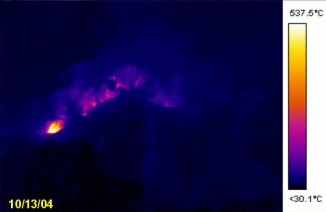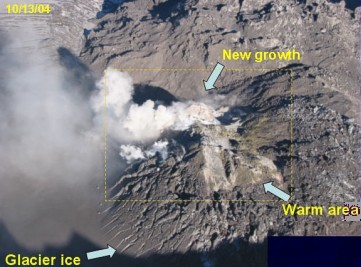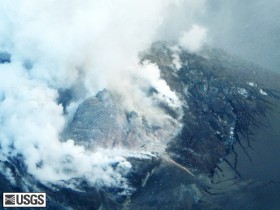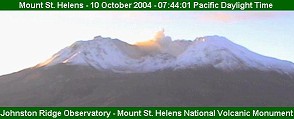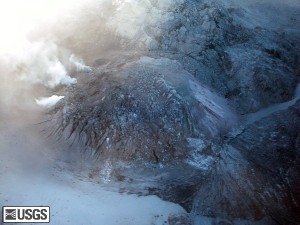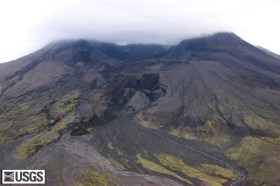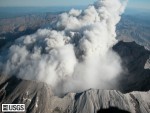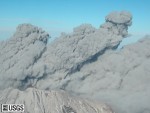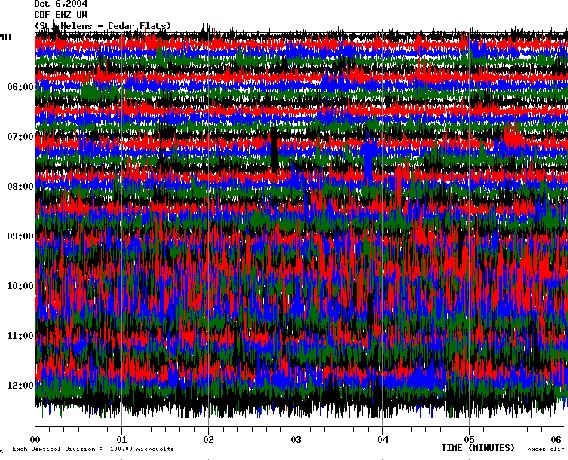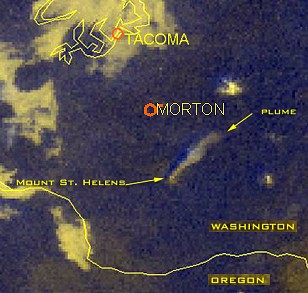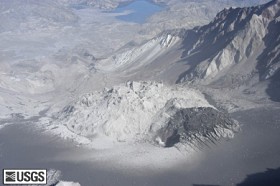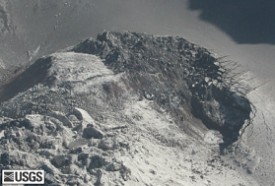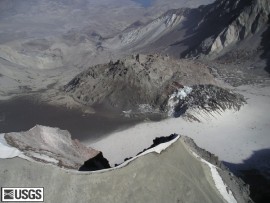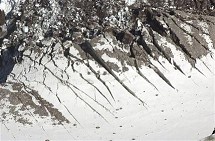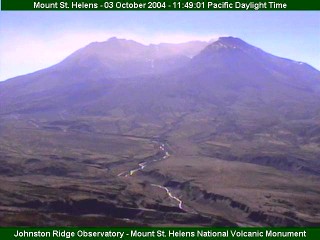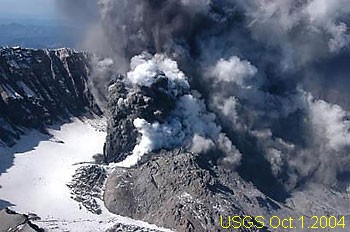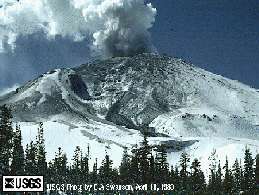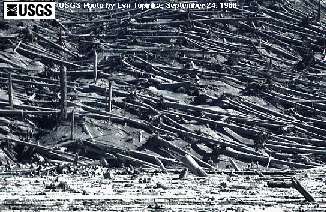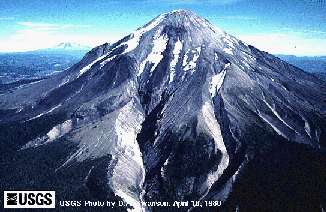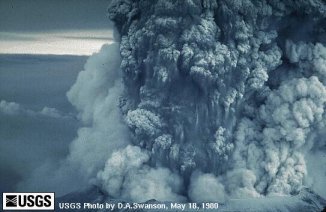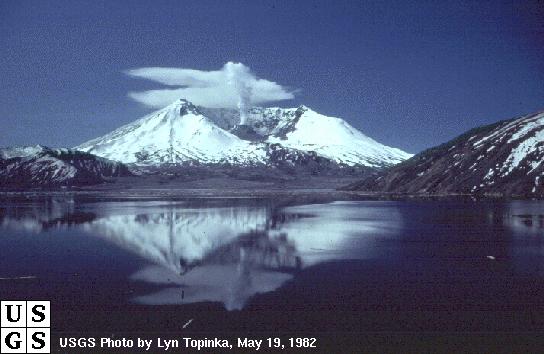Active volcanoes / Aktive vulkaner:
Mount Saint Helens, USA

|
Later events - up to date - click here: St.Helens now. From October 17th till November 7th no reports as we have been away Saturday, October 16th, 2004 As we have to go away, next update will be around November 5th. Till then we recommend you look up the links above. KIRO TV has an excellent page about the ongoing and past activity with several slide-shows and images like these: 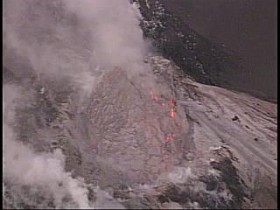 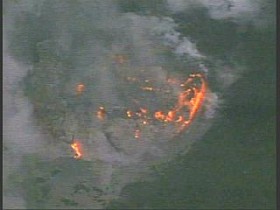
© KIRO TV 
Mount St. Helens uplift with new growth and new avalanche fan, as seen from high angle on the north. USGS Photograph taken on 14 October 2004, by Jim Vallance. The stone ‘‘fin'' on the new lava lobe inside the crater at Mount St. Helens seems to be starting to split, scientists reported Friday. The fin, which is about 200 feet tall and 300 feet wide, is building on the new lava dome, which is about 1,600 feet in diameter and 400 feet high, Friday, October 15th, 2004, 18.15 PDT (Thursday), 01:15 UTC Friday The area of both the uplift and the new lobe of lava have increased slightly since yesterday. Yesterday’s gas-sensing flight detected low levels of sulfur dioxide and hydrogen sulfide, but no carbon dioxide. Abundant steam continues to rise from the area of lava extrusion to the crater rim
Small emissions of steam and ash are possible. Reflection onto steam clouds of incandescence or glow from the hot rock and gases will be visible at night from some locations. Lava-dome growth is a dynamic process and, as we observed in the mid-1980s, Mount St. Helens and similar volcanoes elsewhere typically go through episodic changes in level of activity over periods of days to weeks, or even months. We expect fluctuations in the level of eruptive activity to continue. Escalation could occur suddenly.
Under current conditions, small lahars (volcanic debris flows) could be triggered if hot material from the new lava extrusion swiftly melts glacier ice. Such lahars pose negligible hazard below the Sediment Retention Structure (SRS), but could pose a hazard to people working or recreating along the river channel upstream of the SRS. Furthermore, due to weather and stream-flow conditions at this time of year, it is not unusual for rivers draining the volcano to contain high concentrations of sediment that turn the water murky. There will no longer be daily media briefings at the Headquarters of the Gifford Pinchot National Forest. (From USGS) More lava emerged Thursday on the crater floor of Mount St. Helens, expanding a rock formation building on the volcano's old lava dome. Airborne observers have seen "vigorous jets" of ash and steam near the new growth. Aerial photographs suggest some uplift on one side of the emerging rock "fin." Thursday, October 14th, 2004, 18.00 PDT (Wednesday), 01.00 UTC Thursday
Seismic activity remained at a low level Wednesday, maintaining the slight increase that occurred last night. This morning’s visual observations and thermal imaging of the crater were focused on the intensely deforming and uplifting area on the south side of the 1980-86 lava dome and the new lobe of lava in the western part of that area. The area of both the uplift and the new lobe of lava have increased slightly since yesterday. Temperatures of almost 700 degrees C were measured in parts of the new lobe, from which ash-rich jets rose tens of meters. Abundant steam continued to rise from the area of lava extrusion to the crater rim, from which it was dispersed southwestward by strong winds. From USGS That message verifies what we believed was the glow of lava on the pictures shown below from yesterday. Newspapers in USA have also reported same, and AP press has made a picture available, showing the lave-extrusion - you can see the picture here, at least for a while. Wednesday, October 13th, 2004 noon (norwegian time) 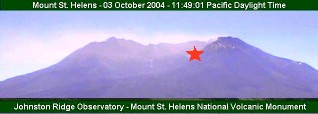   something strange going on..... could it be glowing lava? Compare the two pictures to the right with an old day-time picture(left). Since midnight St.Helens time, or 09.00 CET (norway) there has been spots like these. morning (norwegian time) 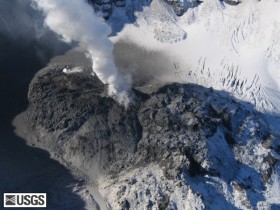 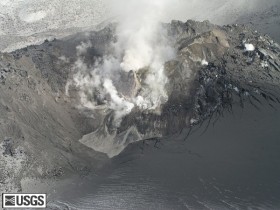
Left: Mount St. Helens dome and uplift from the east. Right: From the west. USGS Photographs taken on 11 October 2004, by Kirstie Simpson and Jon Major Seismic activity remained at a low, but gradually increasing level yesterday. Tuesday morning’s visual observations and thermal imaging of the 1980-86 lava dome, the intensely deforming and uplifting area on the south side of the dome, and the new lava extrusion first seen yesterday afternoon were hampered by steam clouds. Conditions appeared similar to those of yesterday afternoon, with high temperatures (up to 600 degrees C) around the fin-shaped lava extrusion in the western part of the uplift. The area of high temperature appears to have increased in size. Abundant steam continued to rise from the fin area to the crater rim, from which it was dispersed southeastward by strong winds. As a result of the intense unrest of the past two and one-half weeks and recent observations, we infer that magma is at a very shallow level and is likely extruding onto the surface. As last night (Tuesday), incandescence from hot rock or gases could reflect off steam clouds and be visible from north of the volcano. During times of unrest, Mount St. Helens and similar volcanoes elsewhere typically go through episodic changes in level of unrest over periods of days to weeks, or even months. Such changes are in part driven by variations in the rate of magma movement. (From USGS) (Looks very much alike what is going on at Etna at present.) Tuesday, October 12th, 2004 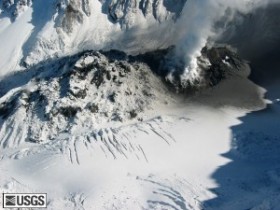  Left: St. Helens dome and uplift as seen from the northwest. Right: Crater and dome from northeast USGS Photographs taken on 10 October 2004, by Jim Vallance Tuesday morning: (midnight in Washington): No change in activity. Smoke coming up, and quakes every 5 to 10 minutes. According to USGS survey Monday, new thermal images reveal that parts of the lava dome in Mt. St. Helens' crater are getting hotter and scientists said that an area on the south side of the dome appeared perforated, as if magma has been hammering at the surface. "What's happened in the last day is the magma is not just pushing up but pushing out. We no longer have just isolated vents. Instead, the whole area is pushing up, the gas is the fuse, just oozing out," a U.S. Geological Survey geologist, said. He said scientists believed the magma, or molten rock, was less than half a mile below the surface. The glacier, which is a newcomer in USA, began to grow after the 1980-eruption. It is now 3,500 feet wide between the south side of the lava dome and the crater wall. Some parts are 600 feet deep, although the average is 325. Scientists are calculating now how much water that translates to. Anyway, it would have to break up an enormous amount of material, if St.Helens wishes to. Only one other volcano -- in Katmai, Alaska -- has hosted glaciers that have grown as quickly as this one. Recent activity at Mount St. Helens is lifting part of the glacier.Some layers are nearly vertical right now at a site on the southeast side of the dome where underground pressures are lifting ice and stone almost as high as the 1,000-foot-tall lava mound. The still-unnamed glacier contains about 120 million cubic meters of snow, ice and rock. Monday, October 11th, 2004 As the sun started to rise Monday in western Washington, a small cloud could be seen rising slowly up from the crater. The volcano vented steam for several hours Sunday. Scientists believe it happened after part of the south side of the lava dome in the crater broke off, taking some of a glacier with it.Seismic activity at the mountain remains relatively low. USGS 07:45 PDT 14:45 UTC Seismicity overnight remained at a low level similar to October 10. Small earthquakes (about magnitude 1) have continued at a rate of about 1 per 5 to 10 minutes. Viewing conditions were very clear most of October 10, and fresh snow had fallen to the level of the crater floor north of the dome. A USGS field crew noticed a thin ash deposit on the snow in the crater and just beyond the crater rim, trending southeast from the active area. A steam plume rose to crater rim level or slightly above all day on
October 10, heading to the Additional analysis of lidar and photographs of the intensely uplifting
area on the south side
Seismic activity has been rising gradually today to a moderate rate of energy release, with earthquakes up to magnitude 2.4 occurring at a rate of about 1 every two minutes. No visual observations of the crater and dome were possible today due to low clouds and rain. AFM data suggest a small lahar flowed out of the crater about midday.
Measurements from recent photographs and LIDAR (an acronym for LIght
Detection And Ranging) show that the intensely deformed and uplifted
area on the south side of the
shortly after 9:00 a.m. PDT, (16:00 UTC) the most vigorous steam and ash emission of the current period of unrest began. See picture below "another one?". The emission originated from the same vent as have others this past week, as well as from another nearby new vent in the intensely deforming area on the south side of the 1980-86 lava dome. For more than one hour, steam clouds billowed from the crater. The ash content varied with intensity of steam jetting from the vent. For the first time, ash content was sufficient that it was detected by National Weather Service Doppler Radar. Steam and ash clouds reached about 12,000 feet and drifted north-northeastward. Ash forecasts warned downwind residents. Media reports indicate that a light dusting of ash fell in Morton, (see sattelite picture above) Randle, and Packwood, Washington, towns about 30 miles from the volcano. Nearby traffic on U.S. 12 stirred up the ash, slightly reducing visibility. We have no reports of ash falling at greater distances. The rate of seismicity dropped during and the emission and has stayed at relatively low rates. We infer that magma is at a very shallow level and could soon be extruded from a vent in the deforming area. Additional steam and ash emissions are likely and could occur at any time without warning. Conditions suggest that there is also an increased probability of larger- magnitude and more ash-rich eruptions in coming days. From USGS Tuesday, October 5th, 2004
16.00 local time in Norway (07.00 AM PDT) 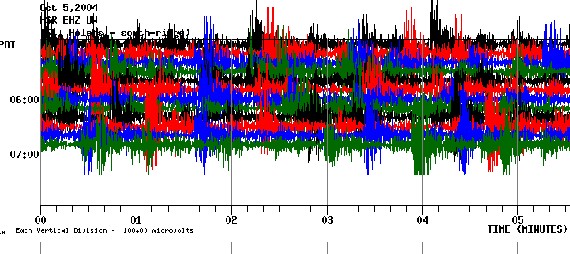 Real time seismic data, from 05:00 to 07:00 PDT, or 12:00 to 14:00 UTC this morning at a seismic station located near the summit. Look like it works...... Visual observations show that the area of uplift, which includes part of the glacier and a nearby segment of the south flank of the lava dome, continues to rise. So far it is reported to have increased by more than 30 meters. Thermal surveys of the dome confirms the deformation. Hot cracks (40-50° C; well below magmatic temperatures) in the dome are opening, and dome rocks are avalanching off the dome into the lake and onto the south crater floor. The north flank of the dome appears thermally stable. Yesterday’s gas-sensing flight detected carbon dioxide, often
in association with hydrogen Yesterday visitors to Mount St. Helens witnessed a 40-minute-long steam-and-ash emission starting at 9:43 PDT. Steam clouds carrying minor ash billowed out of the crater to an altitude of 10,000 to perhaps 12,000 feet. The event did not generate earthquakes or an explosion signal. We infer that hot rock was pushed up into the glacier, melted ice, and generated the steam. Part of the vent for today’s and other steam and ash emissions of the past few days is now covered by a boiling lake. The emission occurred during a time of gradually increasing seismicity, which dropped slightly after the emission, but continued to increase gradually through the afternoon.
Another period of smaller steam and ash bursts occurred between 2:10 and 2:40 P.M. Visual observations show that the area of uplift, which includes part of the glacier and a nearby segment of the south flank of the lava dome, continues to rise. We infer that magma is at a very shallow level and could soon be extruded into the vent or elsewhere in the deforming area. Additional steam and ash emissions are likely and could occur at any time without warning. Conditions suggest that there is also an increased probability of larger- magnitude and more ash-rich eruptions in coming days. Monday, October 4th, 2004 10:00 PDT - 19.00 norsk tid 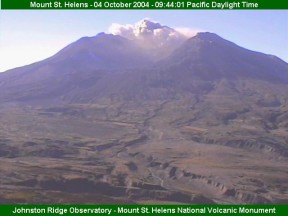  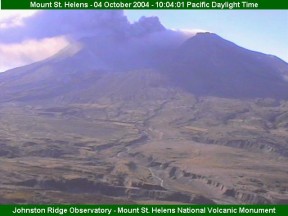  A steam explosion blanketed the top of Mount St. Helens on Monday. The eruption occurred from the south end of the volcano's crater. U.S. Geological Survey said they did not immediately know the ash content of the plume. "Hopefully after this clears away our crews will get a view of
the crater, and the crater will The cloud appeared to be mostly white, and USGS said whatever ash was
in the plume would
Yesterday’s gas sensing flights detected significant concentrations
of carbon dioxide north and Results from GPS measurements indicate no significant deformation of
the outer flanks
Sunday, October 3rd, 2004 Sunday's tremor lasted about 25 minutes and was milder than the 50-minute
tremor that "It just means that what's been happening is still happening"
and the volcano is moving One woman said she saw the plume at midday and was afraid she'd miss
something if she left the area. "I just stare at it and stare at
it. It's too awesome to leave," she said. Current status is Volcano Alert (Alert Level 3); aviation color code RED Overnight (about 3 am) there was a tremor burst that lasted about 25
minutes. No eruptive plume was detected as a result of this tremor.
Following the tremor, seismic activity dropped, but now is at a level
similar to that before the tremor burst. Earthquakes are occurring at
a rate of 1-2 per minute with maximum earthquake magnitudes of about
M3. All earthquake locations remain shallow. During yesterday’s
gas flight, scientists saw an increase in the number of fumaroles on
the lava dome and detected some carbon dioxide. The total amount awaits
further data reduction. Scientists also reported intermittently the
smell of hydrogen sulfide (rotten-egg smell) over the crater. Data from
the GPS instruments on the flanks of the volcano show no significant
changes. Results from the FLIR (thermal imagery) data to date show no
significant thermal anomalies in the crater or on the dome. Scientists
will be in the field today to harden GPS sites, do another FLIR flight,
and conduct another gas flight.
From USGS 7 PM PDT, around midnight in Europe. The increasingly energetic seismic swarm of the past week culminated in a small 25- miunute-long eruption around noon today from a vent just south of the lava dome. The vent opened in a portion of the glacier that had become increasingly crevassed and uplifted over the past few days. This deformation was probably driven by piston- like uplift of a portion of the lava dome and crater floor. The eruption sent a steam and minor ash plume to an altitude of about 10,000 ft. It drifted southwestward accompanied by minor ashfall in areas close to the volcano. Seismicity dropped to a low level for several hours after the eruption, but is gradually increasing with earthquakes (maximum Magnitude about 3) occurring a rate of 1-2 per minute. We infer that the system is repressurizing. As a result, additional steam- and-ash eruptions similar to today’s could occur at any time. erupted for the first time in 18 years today, belching a huge column of white steam and ash after days of rumblings under the mountain. The noontime eruption cast a haze across the horizon as the roiling
plume rose from the nearly |
|
|
